Michael Ruhlman's Blog, page 6
March 31, 2020
Homemade Pasta! Now Is the Time
 Pasta you make yourself has a bite and a lightness that you can’t even get from store-bought fresh pasta.
Pasta you make yourself has a bite and a lightness that you can’t even get from store-bought fresh pasta.Now is the perfect time to cook what you always wanted to but didn’t have the time. Here is one of those universal preparations that we think of as a project and perfect for Cooking in Quarantine. Unfortunately, it’s not that big of a project! Making fresh pasta takes me 1 hour, start to finish (meaning cleaned up, and flour swept up off the floor). And this is to make one batch for dinner and one batch to freeze. If you have flour in the pantry and eggs in the fridge, and a little extra virgin olive oil to drizzle on top, you’ve got an absolutely stellar meal. Don’t have a pasta roller? It’s a little more time consuming but a rolling pin and knife will work.
As I wrote in Ratio, a perfect pasta ratio is three parts flour mixed with 2 parts egg. I weighed my eggs first which would allow me to determine the flour—300 grams (ish). This meant I needed to weigh out 450 grams, a pound, of flour. Or, more practically speaking, 6 eggs and three cups of flour, pinch of salt and dash of olive oil. And it’s good rule of thumb: 2 eggs per cup of flour. And for normal portions, I figure one egg per person, but you always want more, which is why I used 6 eggs for 3 people.
And here’s what six eggs and 3 cups of flour become:
 One and three-quarters pound of fettucini, dusted with corn meal to prevent sticking
One and three-quarters pound of fettucini, dusted with corn meal to prevent stickingIt’s a snap if you use standing mixer. But knead by hand if you wish—it’s meditative and relaxing. I love how a shaggy sticky dough slowly becomes smooth as skin after 10 minutes of kneading. There’s also the meditative nature of rolling it through your pasta machine, watching it thin and expand. Here when rolling it, it’s especially pleasing to touch.
For all the pleasures of making and eating such pasta, there’s also the cost. Something that costs less than 50 cents per serving shouldn’t be allowed to be this good.
Once you see how easy it is, you’ll be wanting to make ravioli or your own lasagna. Lasagna from scratch. Hey, that’s not a bad idea. A community From Scratch challenge during the isolation of Covid-19. A lasagna from scratch, making one component each week–a bechamel, a bolognese, making your own ricotta, how to make simple Italian sausage from store bought ground pork or pork you grind yourself.
As I begin to blog more, I think I might try to focus on cooking projects. One project a week, concluding with one Friday cocktail. Hope you’ll make this pasta–it’s such a pleasure. And don’t miss the video links below the recipe: inspiring!
 Linguini withy plenty of truffle butter!
Linguini withy plenty of truffle butter!
Homemade Pasta
.wprm-recipe-rating .wprm-rating-star.wprm-rating-star-full svg * { fill: #343434; }
How to make your own egg and flour pasta (it's like nothing you can buy)
Course Main Course, Side DishCuisine ItalianKeyword eggs, fettucini, flour, linguini, Pasta
Prep Time 1 hourCook Time 3 minutes
Servings 6 people
Cost $0.45 per serving
EquipmentPasta roller (or rolling pin or pasta rolling pin).
Ingredients1 pound, plus more for dusting, flour AP or "00"6 large eggs1 tbls olive oilto taste saltas needed corn meal optional
InstructionsCombine the ingredients in the bowl of a standing mixer fitted with a dough hook (or in a bowl if mixing by hand). Mix until the dough comes together and forms a sticky ball, 5 to 10 minutes. Turn the dough out on a work surface and finish kneading by hand. Cover with a towel and let rest for at least 20 minutes or up to an hour, or wrap in plastic and refrigerate for up to 24 hours. Cut the pasta into 4 to 6 equal pieces.
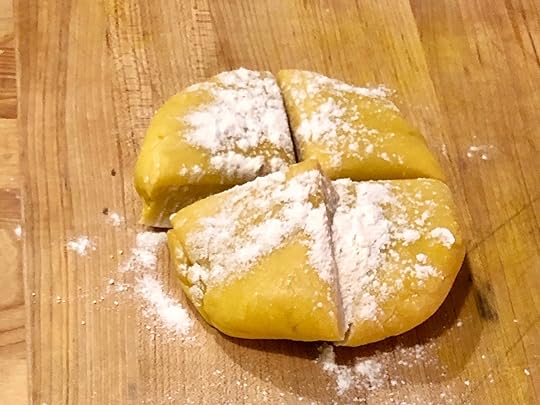 Roll each piece through the widest setting on your pasta roller. (If rolling by hand, roll each piece until it gives resistance, then let that piece rest and relax while you roll the others). Fold each piece in thirds and roll each through the widest setting again. Begin reducing the width of the roller and roll each piece through until you reach the 2nd to last setting. Roll through that, then hang each on a chair or rod to dry while you finish the rest.
Roll each piece through the widest setting on your pasta roller. (If rolling by hand, roll each piece until it gives resistance, then let that piece rest and relax while you roll the others). Fold each piece in thirds and roll each through the widest setting again. Begin reducing the width of the roller and roll each piece through until you reach the 2nd to last setting. Roll through that, then hang each on a chair or rod to dry while you finish the rest. 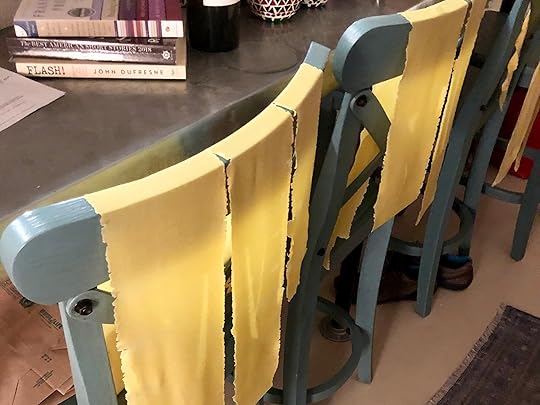 Send each piece through your preferred cutter. You can also roll each sheet, making sure it's well floured, and slice it with a knife to the desired thickness. Toss each batch with corn meal or more flour.
Send each piece through your preferred cutter. You can also roll each sheet, making sure it's well floured, and slice it with a knife to the desired thickness. Toss each batch with corn meal or more flour.  To cook, bring a large pot of water, nicely seasoned with salt, to a boil. Add the pasta and cook until tender, 2 to 3 mintues. Strain, toss with butter or olive oil and eat!
To cook, bring a large pot of water, nicely seasoned with salt, to a boil. Add the pasta and cook until tender, 2 to 3 mintues. Strain, toss with butter or olive oil and eat! Here are a two great pasta videos to inspire. The one from Bon Appetit is killer.
From Bon Appetit, 29 pasta shapes, by Luca Donofrio.
Watch an Italian nonna use a pasta rolling pin to roll out the pasta. (I even did a video demo of how to use a pasta rolling pin way back when. It’s not hard if you take your time.)
You can buy a pasta rolling pin from Vermont Rolling Pins. I had one in my previous life and it was a dream.
March 27, 2020
Friday Cocktail Hour! The Whiskey Sour (for four)
 Mise en place for The Whiskey Sour: Simple syrup, citrus juice, egg white, bourbone (glasses and handblender)
Mise en place for The Whiskey Sour: Simple syrup, citrus juice, egg white, bourbone (glasses and handblender)One of the great pleasures of the cocktail hour is sharing it, especially during these distancing times. The Friday before we bolted New York City, we’d had our friends Bruce Handy and Helen Schulman, both writers, to our apartment for a cocktail pre- our first meal at the new Barbuto. Problems: four cocktails one shaker, and I don’t want to spend half of our time mixing drinks.
Strategy: Go to your arsenal of what I will call Collective Cocktails (like collective nouns, pride of lions, murder of crows, batch of whiskey sours), cocktails that batch well and can be made even before the guests arrive. One of them, (given a Pyrex measuring glass and a hand blender to froth the egg whites) is the whiskey sour. The ones I made for Bruce, Helen and Ann were so good, Bruce shook his head incredulous, and asked for more. They really are that good. (The Whiskey Sour was one of two cocktails I included in From Scratch.)
 If we’d had good cherries, I’d have put three on a tooth pick for each glass, but all we had were limes, so there it is.
If we’d had good cherries, I’d have put three on a tooth pick for each glass, but all we had were limes, so there it is.I find it interesting that so many variations exist, but I stick to standard ratios that are easy to remember and, of course, easy to adjust as necessary. Here, 2 parts bourbon : 1 part simple syrup : 1 part citrus juice : 1 egg white.
Notes: I use an inexpensive bourbon and save the Blanton’s and Michter’s for sipping. Simple syrup is one part sugar dissolved in 1 part water. I make mine in a microwave. Add citrus zest for flavor if you wish. Do this ahead so it has time to chill (it will keep for a week or two in the fridge). Citrus: I’m partial to a lime and lemon mix, heavier on the lime. But one tasting found any lime to be the kiss of death! I’m crazy about limes so I’m keeping mine, but good to know. And of course, the egg white, which is so, so important. It gives the spirit and juice body, and a creaminess to the cocktail both in appearance and on the palate, and it turns a cocktail into a protein drink!
Method: combine all ingredients (you can even use the markings on the measuring glass, no jiggers required), buzz with a hand blender. Prepare 4 glasses with ice, preferably one large cube each, and appropriate garnish. Fill the measuring glass with ice to chill the collective cocktail. Stir and strain into the glasses.
With the weather clement in Rhode Island, and our neighbors self-sheltering responsibly, we’ll hope to share a whiskey sour with them up on the roof, six feet apart, at the end of this day, to take some respite from the heavy news of the day (and with prayers going out to all those in NYC fighting in the world’s newest hot zone).
A muted, but grateful, cheers.
The Whiskey Sour
One of the great cocktails, excellent to make in batches
Course CocktailCuisine AmericanKeyword Bourbon, egg white, Lemon, Lime, sour, Whiskey
Prep Time 15 minutesCook Time 0 minutes
Servings 4 people
Cost Depends on the bourbon!
EquipmentHand blender or standing blender.
Ingredients8 ounces bourbon4 ounces citrus juice, or more as needed lime, lemon, or a mix,4 ounces simple syrup, or more as needed sugar dissolved in an equal amount of water2 egg whites
InstructionsCombine all the ingredients in a large measuring glass and blend with a hand blender. (This can be done in a standing mixer as well.) Taste! Think. If it's too sour, add simple syrup. If too sweet add citrus. If you would like it stronger add 2 to 4 more ounces bourbon. Up to you! Fill the measuring glass with ice and stir to chill. Strain into four glasses over ice.
March 23, 2020
The Generosity of the Slow-Roasted Pork Shoulder (and a giveaway)
 Char siu pork lettuce wraps (photograph by the wonderful Quentin Bacon, the others are mine, alas)
Char siu pork lettuce wraps (photograph by the wonderful Quentin Bacon, the others are mine, alas)Last week, knowing we had to limit our number of trips to the grocery store, and wanting to have plenty of food in the house in uncertain times, I picked up a whole pork shoulder, one of the most generous cuts of meat you can buy and one of the least expensive. I say generous because from this one cut and prepartion (slow-roasting) you can create numerous meals.
Over the course of a week, I made eastern Carolina barbecue, pozole rojo with shredded pork, and char siu lettuce wraps.

You can make goulash (a paprika based stew on egg noodles), a version of Sloppy Joe’s using a tomato sauce and good chili powder served on a bun, a pork ragu on papperadelle).

The below recipe is for a char siu that I love to use with the shredded pork (a variation on a recipe from Andrea Ngyuen in her exceptional book Asian Dumplings–all her books are exceptional, in fact). Serve it in butter lettuce, topped with julienned carrot and radish (and jasmine rice in the wrap or on the side).
To make the pork, cook it for 6 hours covered at 275˚F (or 4 hours at 325˚F), or until you can easily shred the meat, skin and fat. Remove all bones. It’s ready to use in any way you wish.
It’s so versatile, I created a whole chapter around it in my last book, From Scratch: 10 Meals, 150 Recipes.
The giveaway!
In the comments section, simply leave an idea for a use for shredded pork shoulder not mentioned in this post. I’ll choose a winner at random next Monday and my publisher will send you a copy of From Scratch. There is a sad caveat, however: my publisher is unable to ship to Pennsylvania or California due to shelter-in-place rules, so there might be a long delay of the winner can only receive mail in these states.
To make amazing pork lettuce wraps, saute sliced scallions, grated ginger and chopped garlic in oil. Add the pork and stir-fry till heated through. Add enough char sui sauce to coat and serve as noted above.
Char Siu Sauce
.wprm-recipe-rating .wprm-rating-star.wprm-rating-star-full svg * { fill: #343434; }
A fabulous all-purpose Chinese-style sauce
Course Main CourseCuisine ChineseKeyword asian, Char Siu, pork
Prep Time 15 minutesCook Time 2 minutes
Servings 4 people
Ingredients1/2 cup soy sauce1/2 cup hoisin sauce1/4 cup honey1/4 cup dry red wine3 tbls sugar2 tbls red wine vinegar2 tbls toasted sesame oil3 cloves garlic minced2 tsp five-spice powder
InstructionsCombine all the ingredient in a sauce pan and bring just to a simmer, then remove from the heat till you're ready to use it.
March 20, 2020
The Return of The Friday Cocktail Hour: The Perfect Negroni
 The Perfect Negroni: Gin, Campari, white and red vermouth
The Perfect Negroni: Gin, Campari, white and red vermouthHow I’ve missed The Friday Cocktail Hour, this excuse to imbibe fun cocktails, splurge on exotic ingredients, indulge in simple ones. Staying home because of the Covid 19 virus has given me the time and implulse to do it, and to plan for more along with at least one cooking post each week.
My life has gone through a radical change over the past four years, I’m now remarried to a fellow writer, Ann Hood, and we split our time between Providence, RI, and New York City’s West Village.
And it’s in this time of isolation, that I find myself wanting more than ever to reconnect with readers and home cooks and chefs, and so am hoping that a revivified website will allow for that.
Ann, her daughter Annabelle, and I are self-sheltering in Providence; my son, James, is essentially doing the same off-campus at Syracuse U., and my daughter, Addison, now lives and works in Denver, both healthy. Here in Providence, we’ve fallen into a lovely routine. Routine has always provided a sense of security and order, especially valuable now, within a pandemic, with tanking stock market and scores of chef friends closing shop and laying off beloved employees–it’s heartbreaking).
Routine: Paper in bed, midmorning to work, usually a walk to a local co-op grocery store, and an evening cocktail as we begin a movie (chosen lottery style, 12 this past week). This Friday cocktail will be a Negroni. I had my first with Tony Bourdain—it was one of his favorites—after a 92nd St Y event with Eric Ripert and Gabrielle Hamilton, October 26, 2006, would go on to drink many happily with him, and it was what we drank, the last time we drank, more than 10 years later; I have yet to be able rewatch any of his shows.
But not just a regular negroni, a perfect negroni. Perfect in the cocktail world designates a combination of sweet and dry vermouths, rather than one or the other. I had never had a great desire to even try one of these. But on a recent trip to Cleveland (how I miss, you, Cleveland), we entertained at an Air BnB in Ohio City a gang of people, one of whom, the writer Paula McClain, brought a bottle of excellent Spanish white vermouth, Padró & Co.
It was all the push I needed to begin experimenting with “perfect” cocktails—a perfect Manhattan, a perfect Boulvardier. I’ve yet to dare a perfect martini, such is my love for that genuinely perfect cocktail. But the perfect negroni, I discovered, is sublime. I’d go so far as to say it bests a regular Negroni because the latter verges ever so slightly on the too-sweet side. Also, since I’m only having one of these, and prefer both the increased dryness as well as the alcohol, I typically double the gin, a 2-ounce pour per cocktail with 1 ounce each Campari and vermouth. I’ll give the traditional measurements below but feel free to go heavier on the gin, to taste.
I don’t know what Tony would say to The Perfect Negroni, but I hope it would be, “And keep ’em coming.”
Yesterday’s double feature was “Whiplash,” followed by “Billy Elliot”—a coincidentally performing arts theme (highly recommend both). Hoping someone will pull Box Trolls or Ladybird out of the box tonight.
The Perfect Negroni
.wprm-recipe-rating .wprm-rating-star.wprm-rating-star-full svg * { fill: #343434; }
A classic gin cocktail using sweet and dry vermouth
Course CocktailCuisine AmericanKeyword Beefeater, dry vermouth, Gin, Negroni, Perfect Negroni, sweet vermouth
Prep Time 3 minutesCook Time 0 minutes
Servings 2 people
Ingredients2 ounces gin I'm partial to Beefeaters and Hendrix for most cocktails. If you prefer a little more dryness and alcohol—and since I would have just one, this is my preference here—double this, for 2 ounces gin per cocktail. Up to you.1 ounce dry vermouth1 ounce sweet vermouth2 ounces Campari2 orange (or lemon) twists I didn't have orange but that would be my choice.
InstructionsCombine all the ingredients in a measuring glass or divide the ingredients between two glasses. Fill two double old-fashioned glasses with ice, preferably one large cube. Pour the cocktail over the ice in each glass and garnish with a twist. Alternately, fill the measuring glass with ice, stir till chilled and pour divide between two coups and garnish with a twist.
January 15, 2020
From Scratch: Final Episode Season One

Sudha Settharaman, founding director of the Trilok School in Brooklyn, has implemented and unusual food system in her arts-centric school.
Join me for the final episode of my podcast “From Scratch with Michael Ruhlman,” exploring this week’s theme, sharing, one of the most fundamental aspects of food that we don’t give enough credit to.
I also host Ilkay Suuctugu, chef of The Matador Room in Miami, who discusses her improbable rise in the culinary world.
In addition to closing thoughts on the importance of cooking, I finish by discussing and using the Indian technique of tempering dal known as tadka. I found a recipe for it, in my Lemon Cumin Dal, on line from my book Ruhlman’s Twenty.
Season 2 is already in the works and will arrive soon in 2020!
January 8, 2020
From Scratch Podcast: Foraging
 Dr. Todd Pesek, in 2015, as we start out on our trek through the Cleveland Metroparks for an interview for my book Grocery. He’s also an Appalachian root doctor and an expert forager.
Dr. Todd Pesek, in 2015, as we start out on our trek through the Cleveland Metroparks for an interview for my book Grocery. He’s also an Appalachian root doctor and an expert forager.We’re back from the holiday break with a podcast episode on foraging, one of the activities that made our species thrive long ago but about which, today, relatively few people know. I speak with three great foragers, a chef, a professional forager, and a doctor.
Listen to From Scratch with Michael Ruhlman from iHeartRadio, also on Apple podcasts and Spotify or wherever you get your podcasts. If you do, please rate it. It helps other people who love food and cooking find out about it!
Important links from the show.
Matthew Accarino and his restaurant SPQR.
Dr Todd! He’s currently on a cleanse after the rich foods of the holiday. Give his Super Broth a try.
And Nancy MacNamara and her Honey Locust Farm.
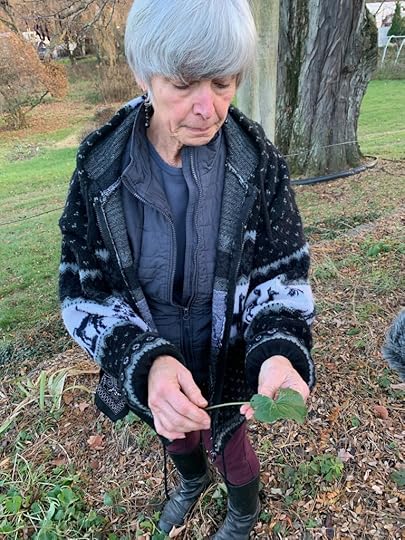 Expert forager Nancy MacNamara of Honey Locust farm, with some ground ivy in the front yard of her childhood home in Newburg, NY (the honey locust tree is in the background).
Expert forager Nancy MacNamara of Honey Locust farm, with some ground ivy in the front yard of her childhood home in Newburg, NY (the honey locust tree is in the background).
December 17, 2019
Roast! From Scratch Podcast
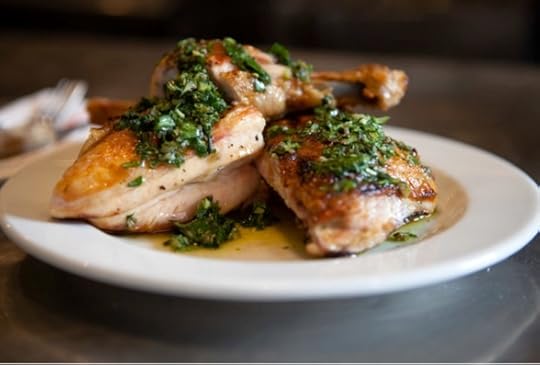 The Barbuto roast chicken, from the New York Times Cooking.
The Barbuto roast chicken, from the New York Times Cooking.When I set out to do a show on roasting, little did I know that it would lead to a discussion of what a perfect restaurant is, what makes a good restaurant, in what way is food important, how do you roast a chicken, and how do you make it magical?
All this and more on this week’s episode of “From Scratch.”
Links from the show are here:
Part of the reason the chicken was so good, beside’s Ann’s excellent basting, was because it came from a great butcher, Hudson & Charles, on Hudson Street in NYC’s West Village.
My new book is out, also called From Scratch, and it’s all about what we can learn from ten staple meals, recipes and inspiration.
I highly recommend Jonathan Waxman’s books, of course.
Ann Hood’s books can be found on her site or wherever your buy books.
And my spoons be can found at the wonderful cooking site JBPrince.
December 11, 2019
Eggnogs!
 Mise en place for aged eggnog.
Mise en place for aged eggnog.It’s that time of the year–and I know this because I was supposed to make the aged eggnog over Thanksgiving but got busy. Only made it last night. Takes all of five minutes once your mise en place is set. (Listen to “From Scratch” podcast on mise en place here! We’ll be back with another episode next Wednesday, 12/18). The gang will likely drink half around the holidays and do our best to save half for next year. We were only able to hide a quart last year, but we’re looking forward to tasting the year-old concoction soon. Year old eggs, year old dairy!
But we also tasted Ga-Ga’s eggnog, made by our neighbor, the estimable writer, Tripp Evans, the eggnog he grew up on in Virginia, best made the night before serving, and a little more gentle than the high-octane, aged eggnog below.
High-Octane Aged Eggnog
12 yolks (save whites for angel food cake!)2 cups granulated sugar1 liter bourbon4 cups whole milk1 cup heavy cream3/4 cup Cognac or brandy1/2 cup Myers’s dark rumpinch of kosher salt
Combine the yolks and sugar in a large bowl and whisk until well blended and creamy.Add the remaining ingredients and stir to combine.Transfer the mixture to a 1-gallon glass jar and tightly seal the lid. (Alternatively, you can bottle it.) Place in the refrigerator for 30 days. (But you’d better try a couple glasses the day after making it just to make sure it’s got the right balance, don’t you think?)Serve topped with sweet meringue and nutmeg if you wish.
Yield: 3-1/2 quarts
Ga-Ga’s Eggnog
13 eggs, separated (why 13? because that’s what recipe says)2 cups bourbon2 cups dark rum1 cup brandy13 soup spoons of sugar (I love this one! so old school)1 quart half-and-half1 pint heavy creamgrated nutmeg to taste
Combine yolks, bourbon, rum and brand and refrigerate overnight.Add all remaining ingredients except the egg whites and stir to combine.To serve, whip the egg whites to soft peaks and fold into the eggnog. Grate more nutmeg on top if you wish.
This should make about 2 quarts of eggnog
December 3, 2019
Awareness
 Corey Chow, per se chef, center, expediting—post “hearing aids,” as recorded on today’s podcast.
Corey Chow, per se chef, center, expediting—post “hearing aids,” as recorded on today’s podcast.Today’s podcast is about “awareness” in the kitchen, the importance of which was taught to me by Thomas Keller, below. A lot of people today talk about “mindfulness,” which was so odd to me I usually asked the speaker to define it specifically. I think a better word for it is awareness, which is what mindfulness, I think, means. Awareness: all senses open. And as we cook with all our senses, awareness is perhaps the most important thing to talk about when we talk about cooking.
In the below photo Keller is The Elder at the side of the pass in The French Laundry Kitchen. Notice the hearth at the back, and the amazing ventilated ceiling (no exhaust hoods, amazing).

And “the elder” is a term of great respect, Chef.
The non-chef expert is a knitter, Kay Gardiner, former United States attorney, now co-conspirator in the daily online magazine Mason Dixon Knitting (and I suspect pretty good cook). I’d asked her to be on the show because I knew from my knitter wife, Ann Hood, that calm and awareness were a part of knitting, but I didn’t know how many connections she’d make between knitting and cooking.
One of my goals has been to connect cooking to other parts of our world, to show how cooking connects us. Kay shows how.
And we listen in on Corey Chow, top, expediting service during the meat courses of a meal at per se.
Thanks all!
Oh, and here’s a link to those famous Robuchon potatoes Kay spoke of. Good photo montage of the late great chef.
Below is Keith Martin’s Elysian Fields lamb with spring vegetables at The French Laundry, thanks to exec chef David Breeden, just because (it’s so beautiful).

November 26, 2019
Chinese Cumin Noodles: Podcast on Mise en Place
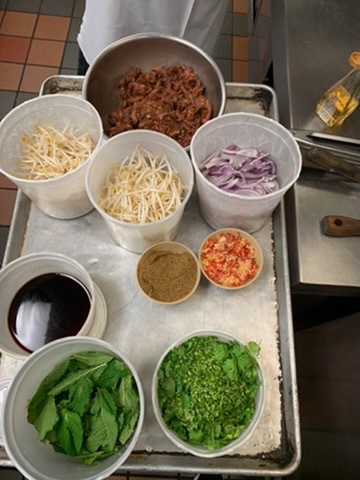 Lamb Cumin Hand Stretched Noodles Mise En Place
Lamb Cumin Hand Stretched Noodles Mise En PlaceNew podcast episode is up, From Scratch, today on the extraordinary power of mise en place.
And here’s the recipe discussed and prepared in the episode.
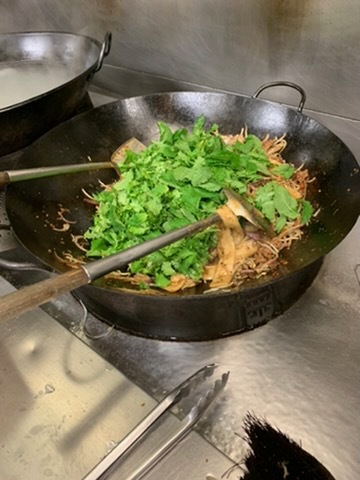

Hand pulled Cumin Lamb Noodles
For the Noodles:
15 ounces (3 cups) flour
1/2 teaspoon salt
10 ounces water
1/2 cup of oil or as needed
For the Lamb:
1 to 1-1/2 pounds lamb shoulder cut in thin strips
1 tablespoon soy sauce
1 tablespoons ground cumin
1 tablespoon corn starch
1 teaspoon dark soy sauce
1 teaspoon ground coriander
1 teaspoon Korean chili powder or 2 teaspoons chili paste such as Go Chu Jang
1 teaspoon toasted sesame oil
1 clove garlic, minced
1/2 teaspoon ground black pepper
Mise To Complete the dish:
1/2 onion, thinly slicedMedium red onion, sliced
1-1/2 cup bean sprouts
1/4 cup sesame oil for cooking the seasoning sauce
Seasoning sauce 1
2 ounces light sesame oil
3 clothes garlic, minced
1 tablespoon ginger, minced
1 red Fresno chili, cut in thin rings
2 tablespoon ground cumin,
1 tablespoon ground coriander, ground
1 teaspoon Korean chili powder or 1 tablespoon Korean chili paste
1 teaspoon black pepper, ground
Combine all ingredients and stir
Seasoning sauce 2
1/4 cup soy sauce
2 teaspoons Shao Xing wine or white wine
2 teaspoons rice vinegar
2 teaspoons light brown sugar
1 teaspoon MSG or fish sauce
1/2 teaspoon salt
Combine all ingredients and stir
Aromatic herbs:
1 bunch cilantro torn
1 bunch mint, leaves only
To prepare noodles:
Combine the flour and salt, add the water, and stir with a wood spoon till the dough comes together. Turn the dough out onto a cutting board and knead it for 5 to 7 minutes until it’s a smooth supple dough. Wrap in plastic and let it rest for 30 minutes or up to a day in the fridge.
Put the oil in a ramekin. Oil a sheet tray. Roll the dough out into a half-inch thick rectangle. Cut the dough into 1/2-inch strips. Coat your hands in oil or dip one strip in oil and pull and pinch and stretch it into a long thin tagliatele like noodle and put it on the sheet tray.
Repeat with the remaining strips of dough.
You can cook the noodles and shock them or cook them while you’re cooking your lamb. Boil it in salted water until tender, 3 or 4 minutes.
To finish the dish:
Get a pan or wok really hot. Give it a coating of oil and lay out the strips of lamb individually so that you get as much surface caramelization as possible. Finish stir frying the lamb.
Add the onion and bean sprouts and cook for another minute or so. Remove it all to a bowl.
Cook or reheat your noodles.
Return the pan to the heat, add a quarter cup of sesame oil, and cook seasoning sauce 2, until it’s simmering. Lower the heat and add seasoning sauce 2. Add the noodles and toss them in the sauces. Add the lamb and toss. Add the fresh herbs and toss and serve.
Serves 4
Michael Ruhlman's Blog
- Michael Ruhlman's profile
- 354 followers



